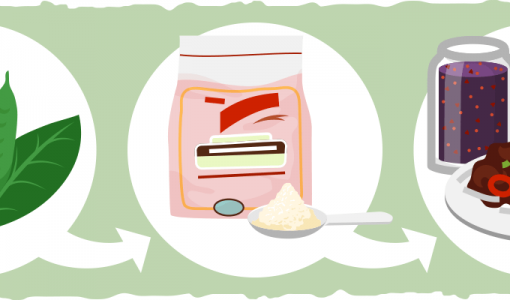What is Guar Gum? Definition, Benefits, Risks, & Uses
Guar gum is typically used as a natural food thickener and binding agent, similar to xanthan gum but with slightly different properties.
Despite the stigma surrounding this common keto-friendly additive, guar gum is safe for most people and provides many health benefits when consumed in moderation. However, there are some caveats that are important to understand before you use it or replace it with a suitable substitute.
To help clear up any guar gum confusion, we put together a comprehensive guide on this versatile ingredient that covers the following topics:
- What is guar gum?
- The benefits of guar gum
- Potential health risks
- Is guar gum vegan, soy-free, gluten-free, etc.?
- Uses and practical examples from keto recipes
- Crucial cooking caveats and tips
- Where and how to buy it
- How to replace guar gum
What is Guar Gum?

Guar gum, also known as guaran and guar flour, is derived from the bean of the guar plant.
To produce the fine gum powder, the endosperm is separated from the rest of the guar bean and milled into a white to yellowish white powder. The powder is then used as a thickener, stabilizer, and/or emulsifier in common food products such as baked goods, gravies, sauces, dressings, jams, dairy products, and dairy alternatives. In addition to its use in food, guar gum is found in cosmetics, medications, toothpaste, textiles, and paper products as well.
Galactomannan — a type of soluble fiber found in the guar bean — is the functional component responsible for the powder’s properties, versatility, and potential health benefits.
The Benefits of Guar Gum

Since guar gum is primarily composed of galactomannan, you can experience the many health-promoting benefits of soluble fiber whenever you consume this common additive.
More specifically, studies on how guar gum intake affects our health indicate that it could be beneficial for us in a variety of ways. Let’s take a closer look at some of these potential benefits:
- Makes weight loss easier. Not only does guar gum help with low carb cooking and baking, but it aids our weight loss efforts as well. A 2015 review of three studies concluded that the soluble fiber improved satiety and reduced the number of calories consumed throughout the day. Even in small amounts that are commonly found in low carb recipes and food products, it was found to reduce overall food intake without increasing hunger. On a keto diet, this may translate to eating fewer calories and burning more body fat.
- Improves digestive health. Studies have found that guar gum can help relieve constipation, promote the growth of good bacteria, and increase stool frequency. One recent study even suggests that supplementing with a derivative of guar gum known as partially hydrolyzed guar gum can help improve irritable bowel syndrome (IBS) symptoms.
- Regulates blood sugar levels. The soluble fiber found in guar gum can slow the absorption of sugar in the small intestine. This can help stabilize blood sugar levels and prevent blood sugar and insulin spikes.
- Optimizes blood cholesterol. Soluble fibers, such as those found in guar gum, have been shown to have an LDL-cholesterol-lowering effect. Using the gum as a food additive can help increase your daily soluble fiber intake, resulting in a modest improvement in cholesterol numbers.
- Acts as a healthy substitute for other thickeners and binders. By using guar gum and other keto-friendly binders and thickeners, you will no longer have to rely on unhealthy ingredients like corn starch and gluten-containing flours. It can even serve as a stabilizer and emulsifier as well.
Can It Be Bad For You? Potential Health Risks of Guar Gum

Guar gum is safe to use and consume as a part of food products and recipes. Animal studies conducted to test its safety have concluded that it is not carcinogenic and does not impair fetal development.
Human trials indicate that larger doses of up to 15 grams are typically well-tolerated. Since this is significantly more than most people would encounter in low-carb recipes and food products throughout the day, the likelihood that guar gum will cause any side effects is relatively low.
That being said, there a several instances when it would be best to avoid guar gum:
- Avoid it If foods with guar gum trigger digestive issues. Small amounts may cause unpleasant symptoms in those with sensitive digestive systems. If you have gut issues, like small intestinal bacterial overgrowth (SIBO) or IBS, it may be best to avoid guar gum to see if it improves symptoms. For those of you who find it doesn’t cause any issues or that it promotes gut health, feel free to keep it in your diet.
- Avoid inhalation or consumption of the dry powder. When the powder is inhaled or ingested, it can swell and expand causing severe side effects, including pulmonary embolism, esophageal tears, small bowel obstruction, luminal obstruction, and death. For this reason, it is best to avoid inhaling the powder and to stay away from any supplements that contain guar gum powder (unless it is processed into a non-swelling alternative like partially hydrolyzed guar gum). Guar gum powder should only be consumed in small doses after being incorporated into a recipe or food product.
- Avoid if it triggers an allergic reaction. Some studies have found that it is possible for people with soy allergies to react to the guar bean proteins found in guar gum powder (since they are both members of the same plant family). However, this is a very rare occurrence. It is also possible for workers who are exposed to copious amounts of guar beans and powder to develop an allergy as well. In both cases, common allergic responses include trouble breathing, flushing, itchiness, diarrhea, and asthma.
Overall, guar gum is only found in recipes and products in relatively small doses, so it will be safe and healthy for you unless your immune system or digestive system react to it in a negative way.
Other Common Concerns: Is Guar Gum Vegan, Soy-free, Keto-friendly, Gluten-free, and Non-GMO?
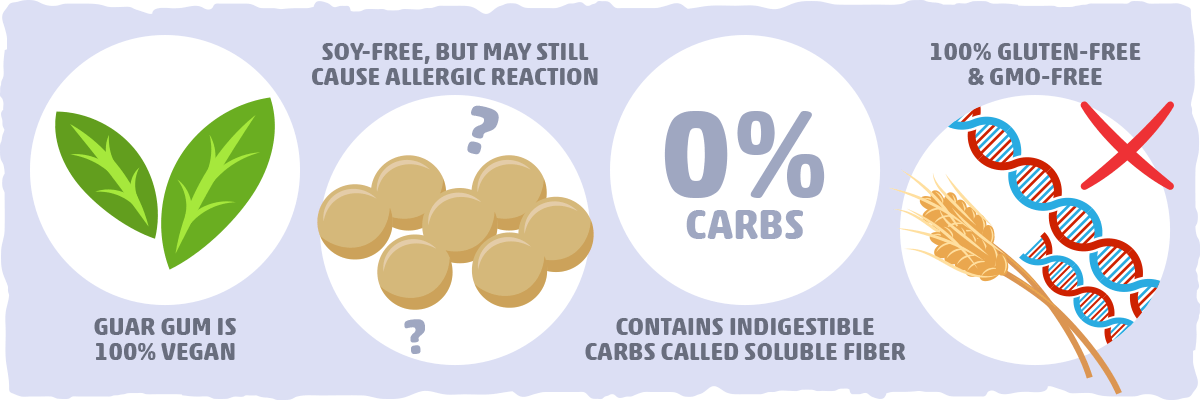
It may sound foreign and artificial, but guar gum is simply the soluble fiber powder extracted from the guar bean with no frills or additives. Thus, it is friendly for most health-conscious consumers in a variety of ways.
Is Guar Gum Vegan?
Guar gum powder is 100% vegan. It is extracted straight from the endosperm of the guar bean with nothing else added and no animal products used during the process.
Is it Soy-free?
There is a lot of conflicting information online about soy and guar. Some say that there are soy proteins in the guar gum products, but no reliable sources back this up.
The truth is that, since guar and soy are both legumes, someone with a soy allergy might react to proteins from the guar bean as well. Technically, pure guar gum powder is soy-free, but in rare cases, those with a soy allergy may also react to the small amounts of guar proteins found in the powder.
Is it Keto-friendly?
Although guar gum is technically classified as a carbohydrate, it is an indigestible type known as soluble fiber. This means that it contributes a relatively small amount of calories to the diet (after it is fermented into short-chain fatty acids in the large intestine), but it doesn’t contain any net carbs.
Is it Gluten-free and Non-GMO?
Since guar gum powder is derived from a gluten-free and non-GMO plant, it is 100% gluten-free and non-GMO. The guar plant is also a relatively sustainable crop, so it is unlikely to be subject to artificial genetic modification.
The Many Uses of Guar Gum
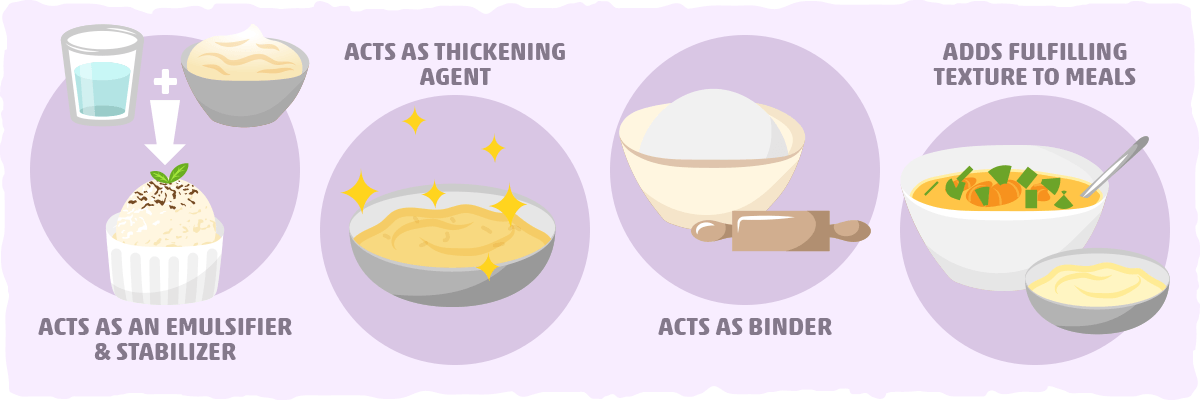
The most common uses of guar gum in low carb recipes and products are as follows:
- Acts as an emulsifier and stabilizer — It’s very useful for keeping thinner ingredients (like water) mixed with thicker ingredients (like oil or cream) while preventing solid particles from settling. Just a small amount of the powder can help prevent separation and promote uniformity. This makes it the perfect additive for keto ice cream, popsicles, jams, and condiments.
- Act as a potent thickening agent — Guar gum has about eight times the thickening ability of cornstarch, so it can be used in places of starches and flours to thicken sauces and gravies. Since it has no net carbs and is a healthy source of fiber, guar gum makes the perfect keto-friendly thickener.
- Acts as a binder — It can be used to bind together ingredients in some low-carb doughs and batters. Xanthan gum, flaxseed meal, and/or psyllium husk powder are typically used for this purpose, but guar gum can serve as a suitable substitute in some recipes.
- Adds a fulfilling texture to meals — If your soup, stew, gravy, or sauce is lacking the heartiness you want with each spoonful, guar gum may be exactly what you need. Just a small amount can be used to add the right texture, thickness, and/or creaminess to your meal.
To develop a better understanding of how this additive is incorporated into a low-carb or keto diet, let’s take a look at some keto recipes that rely on its versatility.
Practical Examples of Guar Gum in Keto Cooking and Baking

Although the cookies themselves don’t require guar gum, that delicious glaze does — and they aren’t the same without it. The thickening properties come through to give the glaze a perfectly gooey consistency.
That crispy coating found in many of our Chinese food favorites is commonly the result of carb-ridden starches and flour — and far from being keto-friendly. However, with the right mix of keto ingredients and guar gum, we can mimic the texture and taste of our favorite dishes without the need for processed carbs.
Take our crispy sesame beef dish for example. In this recipe, we use guar gum’s binding properties to help hold the low-carb flour on the beef strip and create a crispy, fulfilling coating.
Each one of guar gum’s uses will be on display when you make this delicious keto rendition of an Indian cuisine classic. Just a teaspoon of guar gum is all you’ll need to thicken the curry, improve the mouthfeel, and hold all the flavors and ingredients together for every bite.
In sugar-filled popsicles, guar gum is typically used to create a uniform flavor with a refreshingly icy, yet slightly creamy texture. In this keto popsicle recipe, you’ll use it for the same purpose, but instead of getting a sugar spike with each bite, you’ll get a fulfilling dose of healthy fat.
Guar Gum Cooking Caveats and Tips
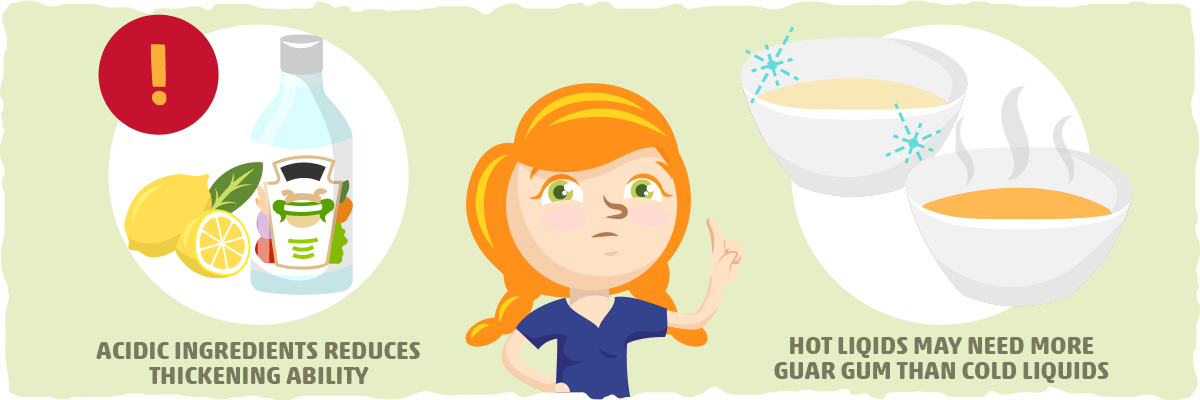
After getting a taste of what guar gum can do for your low carb lifestyle, you may want to start trying to use it in your own keto creations. However, before you start experimenting with guar gum, it is important to be aware of two caveats:
- Acidic ingredients can reduce its thickening ability. Ingredients with a high acid content (such as lemon juice and vinegar) can weaken guar gum’s thickening powers. For meals featuring citrus, vinegar, and/or other acidic ingredients, you will want to use xanthan gum or increase the amount of guar gum.
- Hot liquids may require a bit more guar gum than cold liquids. Cassidy Stockton of Bob’s Red Mill writes that for each quart of liquid in hot recipes, such as gravies, sauces, and stew, use between 1 and 3 tsp of guar gum. For cold recipes like salad dressing, popsicles, puddings. or ice cream, use 1 or 2 tsp per quart.
To maximize its effectiveness, guar gum should be added to the oil component in a recipe, making a complete mix of oil and gum before adding it to the other liquid ingredients. Using a blender or a food processor is the best way to get the powder to dissolve properly.
In general, guar gum is most effective in cold foods, while xanthan gum — a popular keto-friendly substitute for guar — is better for baked goods and recipes with acidic ingredients.
Where and How to Buy Guar Gum
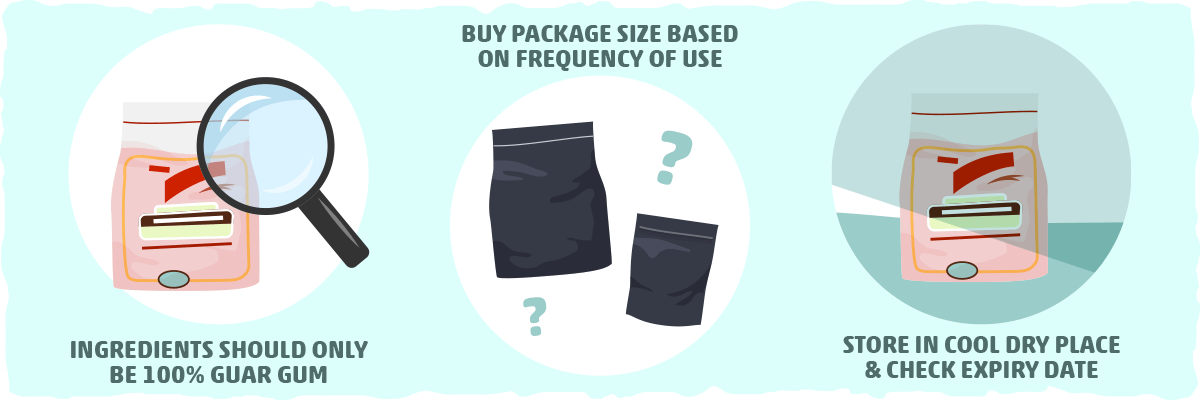
When you go to purchase guar gum, you’ll notice there are plenty of powders available online and in-store. Most major grocery chains, natural food stores, and big-box stores like Walmart and Target will carry at least one brand in the baking section. You may also find guar gum powder in the gluten-free or supplement sections if your store doesn’t carry it in the baking aisle.
Look for a fine guar powder when using it in recipes, and avoid the types that are more coarsely ground. Bob’s Red Mill guar gum and NOW Foods guar gum powder are both great options in this regard.
If your local establishment doesn’t sell it, you can find dozens of different guar gum products online. To save you some time, here is an Amazon.com link for our preferred powder.
You may encounter partially hydrolyzed guar gum as well. This is a non-viscous, non-gelling form of guar gum that should be avoided for all cooking, baking, and food preparation purposes.
If you need help deciphering between guar gum products, make sure to consider these factors:
- The only ingredient should be guar gum. Avoid any product with partially hydrolyzed guar gum, Sunfiber, or anything else in it other than guar gum powder.
- Frequency of use. Guar gum isn’t used much in keto and low carb recipes in comparison to other ingredients with similar properties like xanthan gum and psyllium husk fiber. Buying the powder in smaller quantities, of around 8 ounces per purchase, will likely be more than enough to last you for 6 months or so. However, if you keep a few recipes with guar gum in your weekly rotation, then you may want to purchase it by the pound for cheap. Each ounce of guar gum powder will provide you with roughly 9.5 teaspoons, so keep this in mind when looking for the right product.
- Expiration date and storage. Make sure to store your powder in a cool & dry place, away from heat and sunlight. If it is exposed to humid conditions, the product will absorb moisture, lump together, and lose most of its useful properties. When stored properly, the powder typically has a shelf-life of 12 to 18 months.
After taking these points into account, finding the right product for you among the many options will be much easier. If you are still not sure how much to buy, you may want to go with the cheaper option first, and give yourself a few weeks to figure out how much you tend to use on average.
Guar Gum Substitutes
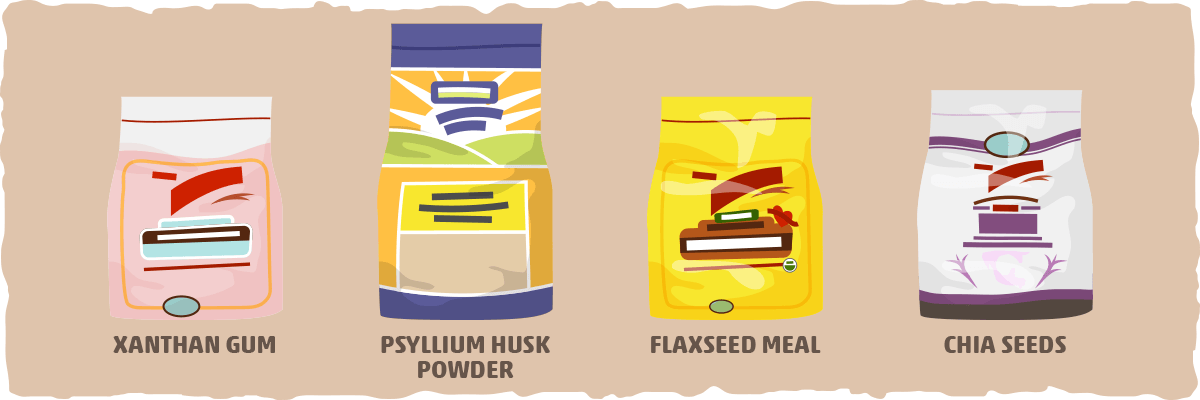
The best alternative for guar gum in keto and low-carb recipes is xanthan gum. If the recipe states that you should use 1 teaspoon of guar gum, try using 2/3 teaspoon of xanthan gum as a substitute.
Since xanthan gum is much more effective at thickening and binding in hot liquids and recipes containing acidic ingredients, you might need to use a bit less than a ⅔ teaspoon in these cases.
However, before you replace guar with xanthan gum, it is important to know the primary differences between the two. For more information on this topic, read through our recent guide to xanthan gum.
If you don’t have access to guar or xanthan gum, then you can try using psyllium husk powder, flaxseed meal, or chia seeds as a substitute in baked goods or to thicken keto smoothies and shakes. Follow the same ratio as you would for replacing guar with xanthan gum, just make sure to add 3 tbs and 2 tbs of water when using chia seeds and ground flaxseeds respectively.
Putting It All Together — Guar Gum for the Ketogenic Diet
For most people, guar gum is a healthy, helpful, and allergen-free food additive. Like xanthan gum, it consists of 100% soluble fiber (I.e., it has zero net carbs) and is used as a thickener, stabilizer, and/or emulsifier in common foods and industrial products.
When consumed in the small doses commonly used in keto-friendly food products and low-carb recipes, guar gum is safe and can even provide us with many benefits, from helping with fat loss to improving cholesterol levels.
The ideal alternative for this additive is xanthan gum because it has all of the same properties and holds up well when exposed to high temperatures and acidic solutions (unlike guar gum). For more information about xanthan gum and other common keto baking ingredients, check out these articles:
- What is Xanthan Gum? Benefits, Risks, Uses, and Keto-friendly Substitutions
- What is Psyllium Husk? Benefits, Side Effects, Substitutions, and More
- Keto Flours and Their Substitutions
Sources
- GUAR GUM: Chemical and Technical Assessment — FAO
- Guar gum as a promising starting material for diverse applications: A review. — NCBI
- Esophageal and small bowel obstruction from guar gum-containing “diet pills”: analysis of 26 cases reported to the Food and Drug Administration. — NCBI
- Is Guar Gum Healthy or Unhealthy? The Surprising Truth — Healthline
- Occupational allergic rhinitis from guar gum. — NCBI
- Guar gum: Processing, properties and food applications – A Review — ResearchGate
- Occupational asthma caused by guar gum. — NCBI
- Guar, Guar gum — Thermo Scientific
- Guar Gum — Nutrients Review
- Partially Hydrolyzed Guar Gum in the Treatment of Irritable Bowel Syndrome with Constipation: Effects of Gender, Age, and Body Mass Index — NCBI
- Randomized clinical study: Partially hydrolyzed guar gum (PHGG) versus placebo in the treatment of patients with irritable bowel syndrome — NCBI
- Hydrolyzed guar gum decreases postprandial blood glucose and glucose absorption in the rat small intestine. — NCBI
- Guar gum in insulin-dependent diabetes: effects on glycemic control and serum lipoproteins. — NCBI
- Post-meal perceivable satiety and subsequent energy intake with intake of partially hydrolysed guar gum — British Journal of Nutrition
- CFR – Code of Federal Regulations Title 21 — FDA
- Guar Gum vs. Xanthan Gum — Bob’s Red Mill
- Effects of guar gum in male subjects with hypercholesterolemia. — NCBI
- PACKAGING & STORAGE — Raj Gum Industries
The post What is Guar Gum? Definition, Benefits, Risks, & Uses appeared first on Ruled Me.
